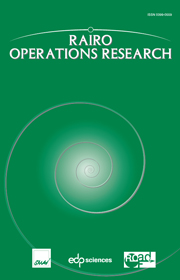No CrossRef data available.
Article contents
Une nouvelle transformation des réseauxde Petri généralisés : L'abstraction généralisée
Published online by Cambridge University Press: 15 April 2004
Abstract
Cet article introduit une nouvelle transformation des réseaux de Petri généralisés appelée l'abstraction généralisée. C'est une réduction dont nous montrons qu'elle conserve les invariants du réseau de départ et les propriétés structurelles les plus importantes. Une fonction de transformation de marquages nous permet d'introduire l'étude de la conservation des propriétés comportementales.
- Type
- Research Article
- Information
- Copyright
- © EDP Sciences, 2004
References
G. Berthelot, Transformations et analyse de réseaux de petri. Applications aux protocoles. Thèse de doctorat d'état és sciences, Université Pierre et Marie Curie, Paris VI (1983).
Berthelot, G., Transformations de Réseaux de Petri.
TSI
4 (1985) 91-101.
G.W. Brams, Réseaux de petri: Tome 1 – Théorie et analyse. Masson, Paris (1983).
E. Daniel, P. Kuntz and B. El hajjaji, Détermination des cellules (place, transition) à abstraire dans un RdP généralisé et génération des matrices d'incidence du réseau résultant. Rapport de projet de fin d'études sous la direction de C. Haro, E3I–Université de Tours (1999).
J. Desel and J. Esparza, Free Choice Petri Nets. Cambridge Tracts Theoret. Comput. Sci.
40 (1995).
I. Koh and F. Dicesare, Modular Transformation Methods For Generalized Petri Nets and Their Application to Automated Manufacturing Systems. IEEE Trans. Systems, MAN Cybernetics
21 (1991) 1512-1522.
H. Lee-kwang and J. Favrel, Hierarchical Reduction Method For Analysis and Decomposition of Petri Nets. IEEE Trans. Systems, MAN Cybernetics
15 (1985) 272-280.
H. Lee-kwang, J. Favrel and P. Baptiste, Generalized Petri Net Reduction Method. IEEE Trans. Systems, MAN Cybernetics
17 (1987) 297-303.
J.Y. Morel, Contribution à la modélisation et à l'analyse des systèmes à événements discrets par réseaux de Petri généralisés et colorés. Thèse de troisième cycle, ISTIA – Université d'Angers, Angers (1996).
Narahari, Y. and Viswanadham, N., Petri Net Approach, A to The Modelling and Analysis of Flexible Manufacturing Systems.
Ann. Oper. Res.
3 (1985) 449-472.
CrossRef
I. Suzuki and T. Murata, Stepwise Refinements of Transitions and Places, in IFB 52, edited by C. Girault and W. Reisig. (1982) 136-141.
Valette, R., Analysis of Petri Nets by Stepwise Refinements.
J. Comput. Syst. Sci.
18 (1979) 35-46.
CrossRef
M. Zhou, F. Dicesare, A.A. Desrochers, A Top-Down Approach to Systematic Synthesis of Petri Net Models for Manufacturing Systems, in Conf. Robotics and Automation, Scottsdale – Arizona, May (1996).
M. Zhou, K. Mcdermott and P.A. Patel, Petri Net Synthesis and Analysis of A Flexible Manufacturing System Cell. IEEE Trans. Systems, MAN Cybernetics
23 (1993) 523–531.


